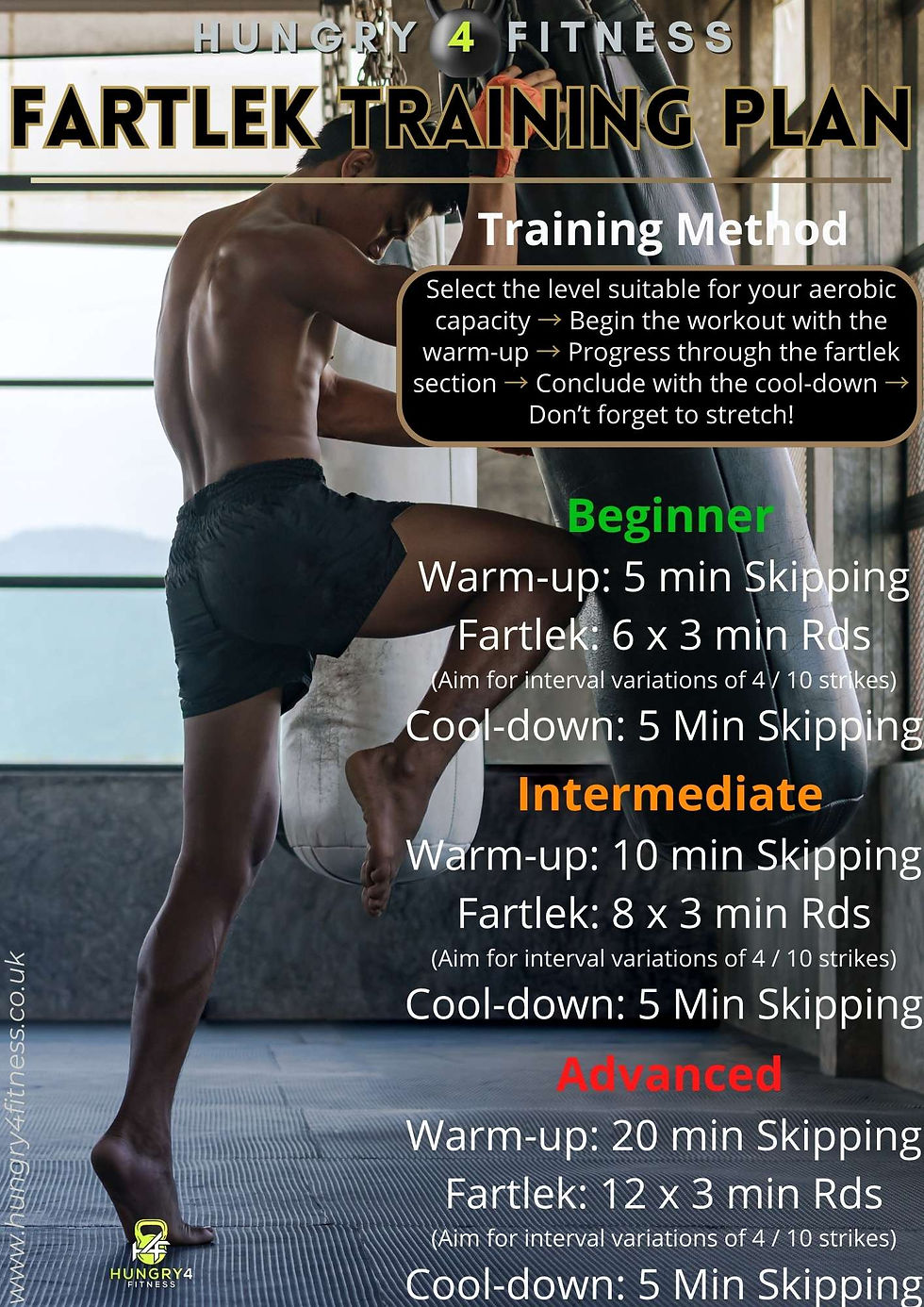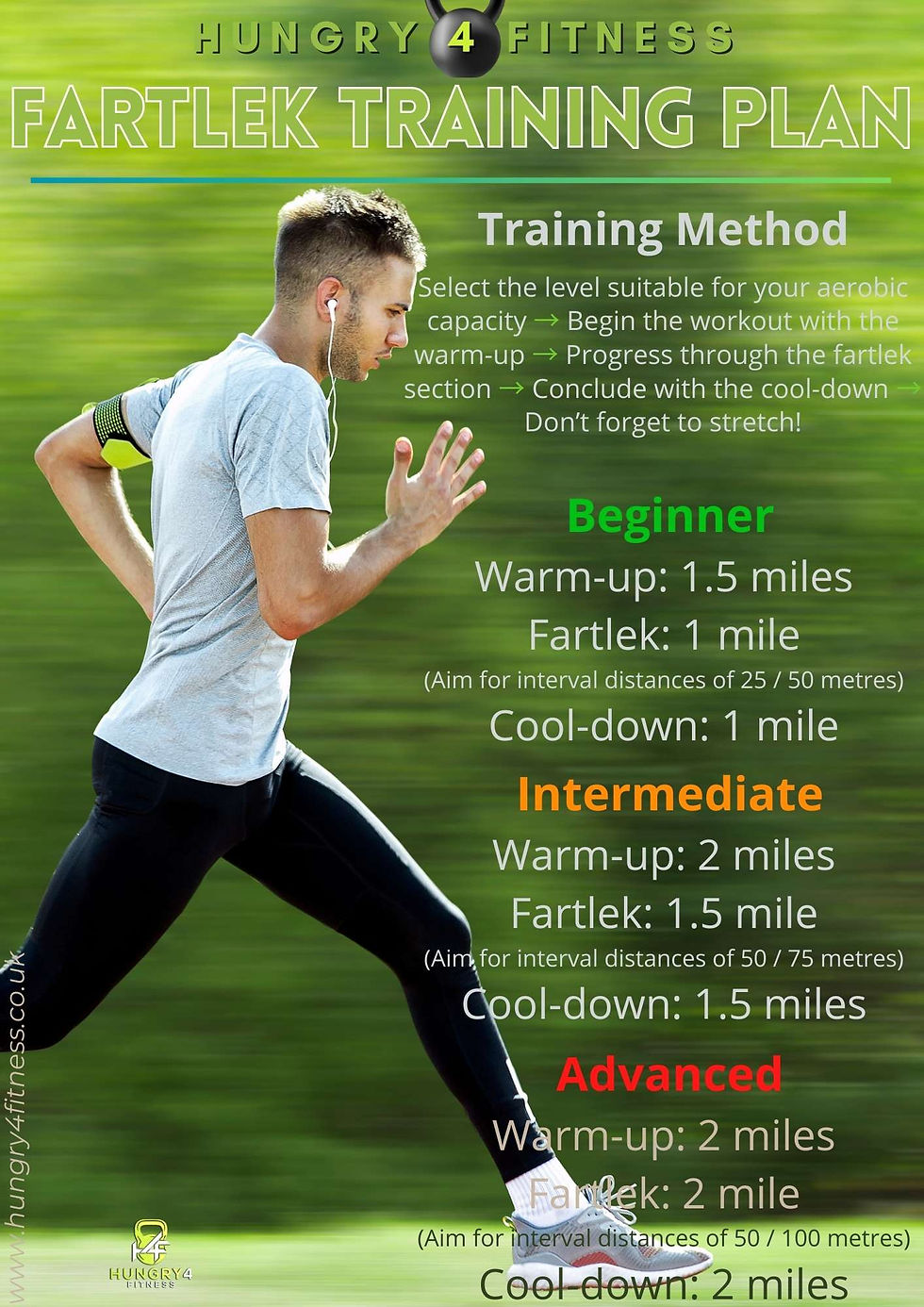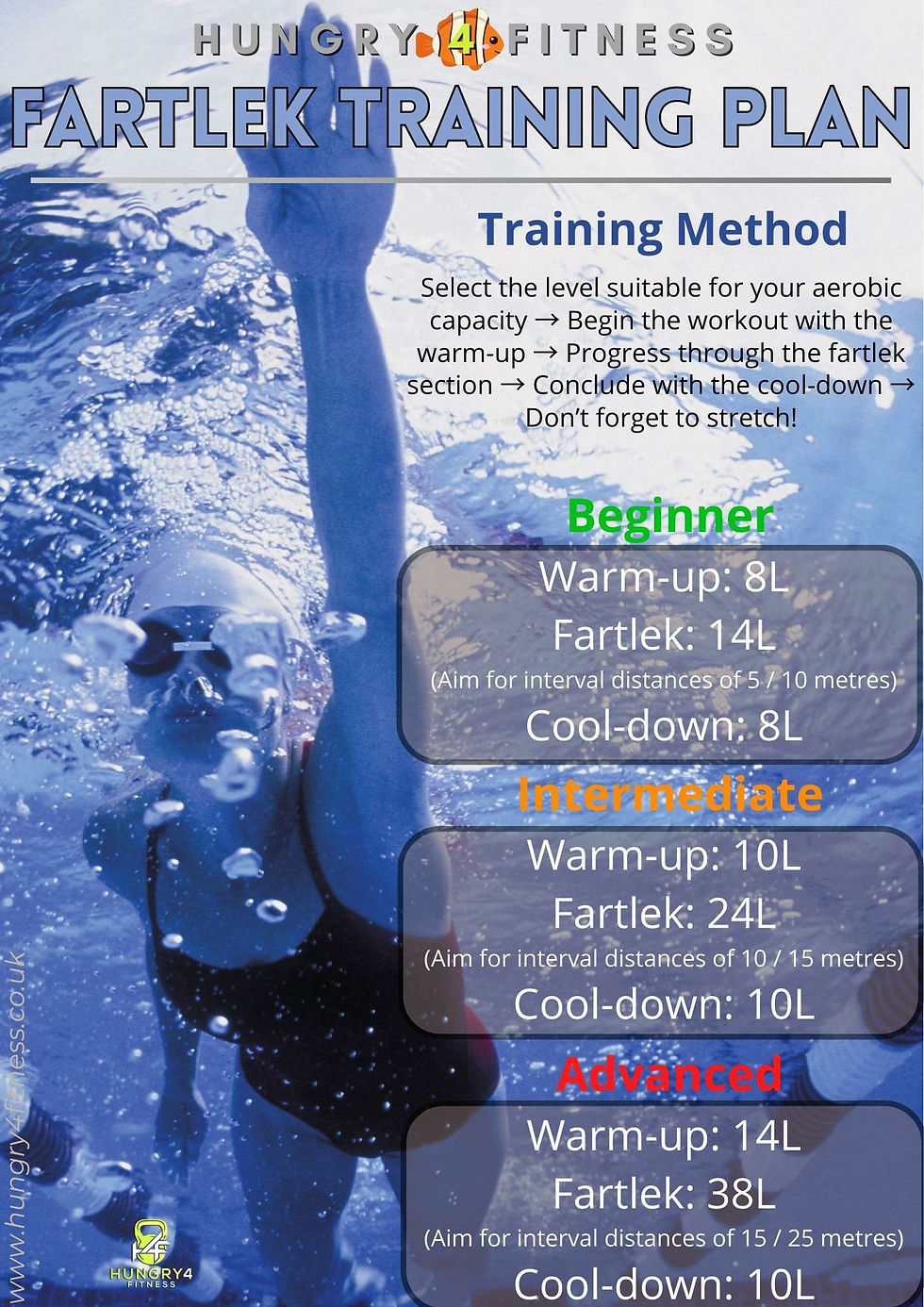Fartlek Workouts For Exercise & Sport
- Hungry4Fitness

- Feb 3, 2024
- 6 min read

This site contains product affiliate links. We may receive a small commission if you make a purchase after clicking on one of these links.
Fartlek workouts are a great way to keep your training ‘fresh and fun.’ In addition to adding some much-needed flavour to bland bouts of cardio, fartlek has been shown to improve ‘various components of cardiorespiratory as well as performance efficiency,’ (NSCA’s Essentials of Tactical Strength & Conditioning). (Want to know more benefits of fartlek training?)
Another string to the fartlek training bow is its flexibility. As you’ll soon see, fartlek can be applied to a broad range of sports and exercise activities. And because fartlek is not as ‘formulaic’ as HIIT (high-intensity interval training), it can be applied as and when you feel like turning up the heat.
That brings us to the purpose of this blog. Below, you will find three fartlek workout plans. The plans have been crafted around a mixture of training pursuits.
In the following quick finder, you’ll be able to locate the plan most suited to your exercise preferences and fitness goals.
Fartlek workout quick finder
Fartlek workout #1: Combat sports >
Workout One is geared up for combat sports practitioners – boxers, Thai boxers, and mixed martial artists. I’ll show you how fartlek training can be applied to promote combat conditioning. This will enable you to develop cardio fitness which is an essential attribute of all fighters. Also, we’ll review how fartlek can be incorporated into sport-specific drills.
Fartlek workout #2: Aerobic fitness >
The second fartlek workout will improve your aerobic and anaerobic fitness. To achieve this objective, the fartlek method has been applied to a series of conventional training tasks – running, cycling, and rowing. This training plan can be taken to the gym or outdoors.
Fartlek workout #3: Sports conditioning >
Our third fartlek instalment is shaped around enhancing sports conditioning. The training tactics used are similar to the second fartlek workout. However, where workout three differs is in the application to sports-specific scenarios. Instead of producing a plan for every sport, I have sketched out a blueprint that will enable you to apply fartlek to your sporting discipline.
Fartlek workout #1: Combat sports
All combat sports require equal measures of aerobic and anaerobic conditioning. Picture the boxer facing down her opponent. For the most part, she is in cruise control: moving in and out of range, throwing feints and pot shots while attempting to expose chinks in her opponent’s armour. This is all aerobic.
But suddenly and without warning our boxer must fend off an offensive attack. On her heels bobbing and weaving, she counters with a rapid-fire combination – jab-jab, right, left to the body and back up to the head. This is very much anaerobic.
This brief snapshot of a boxing match is almost identical to a fartlek workout. That is, long periods of steady state punctuated by explosive, short-duration high-octane intervals.
Get fighting fit with fartlek
Combat sports practitioners (that includes MMA, K1, Muay Thai, and Greco-Roman wrestling) can integrate fartlek into multiple different training tasks and scenarios. First off, they can throw in a few miles towards the end of an aerobic conditioning session. But also (and this idea is far more engaging), they can fartlek strike combinations on the punching bag, pads, or during sparring.
This is perfectly acceptable for the simple fact that fartlek is high-intensity interval training. And it doesn’t matter what form of exercise it’s applied to either. All that matters is that the intensity is near maximal, and the exposures vary in length and are launched arbitrarily.
Combat sport fartlek training plan

Fartlek workout #2: Aerobic fitness
As we saw above, fartlek training is fabulously flexible. And it’s not just a last-minute ingredient to flavour a bland long, slow distance (L.S.D) run. Fartlek is like seasoning: it can enhance the taste of any workout. This attribute makes fartlek an effective method of improving general fitness conditioning.
Yes, fartlek can kick-start that limp L.S.D session. But it’s no one-trick-pony. I hope you’re sitting down for this revelation: fartlek can be incorporated into any cardio exercise.
Simmer down a second. I can sense that you’re getting excited. ‘What, you mean to say that I can fartlek on the stationary bike?’ Yup. ‘And on the rower?’ Certainly. ‘And on the cross-trainer too?’ Yes! You can even fartlek while swimming (see final fartlek workout plan).
Fartlek run training plan

Fartlek and resistance training
The fartlek fun doesn’t stop at cardio. We’re not even warmed up yet. Hard tough it is to believe but resistance exercises are fartlekable. Instead of fluctuating the speed and power outputs – as when running and cycling – we increase the rep tempo and lifting velocity. Here’s how you can fartlek when swinging a kettlebell.
First, you need to know your low- to medium-intensity repetition per minute (RPM) range. This is the equivalent of steady-paced jogging. Let’s say that with a 16kg kettlebell between 12 to 14 swings per minute is your aerobic training zone. And you can comfortably sustain that output for several minutes.
Now you need to work out your high-intensity ‘fartlek’ equivalent. If we put the number at about half that of your comfortable range, so between 18 to 21 RPM, this would be your fartlek bout.
Right, armed with that knowledge, you can start fartleking. To do so, set a 5 to 10-minute countdown timer – you’ll need to be able to see it so that you keep track of your reps against the ticks. Start by settling into your comfortable ‘jogging’ RPM (12 to 14 reps).
Once you’ve been plodding along for a few minutes, prepare to fartlek. Do this by trying to cram 18 to 21 reps into 60 seconds. It makes life easier if you initiate your fartlek bouts at the start of each minute. That’s a kettlebell swing version of sprinting.
Fartlek training ideas

Fartlek workout #3: All sports
All sports practitioners (except golfers) can benefit from fartlek training. Instead of trying to explain the applicability to every relevant sport, I’ll focus this discussion on one. From that example, you’ll see how fartlek training can help improve sports performance.
The intensity fluctuations during a rugby match closely reflect the fartlek protocol. For the majority of their time on the pitch, players are chugging along aerobically – jogging up and down the field, walking about while a teammate disputes the validity of the ref’s call.
But out of the blue, the player receives the ball and within a single stride, they’re at maximum intensity. And this intensity will be sustained until they cross the line or are mobbed into submission by the opposition. Seconds later they’re back in the aerobic zone – until the next pass.
If you removed the rugby-related words, many other sports would fit that description. Football, tennis, basketball – even cricket! You could go so far as to say that these sports are the competitive rule- and skill-based forms of fartlek training.
Fartlek training improves sports performance
Sports practitioners can use fartlek training in one of two ways. The first is for general fitness conditioning. While out on a run they can use those lampposts as fartlek makers (after all, that’s why the council put them there for). As we’ve discussed above, interval training is an effective method of increasing both the aerobic and anaerobic threshold. Over time, this will enable you to maintain higher outputs during competitions.
The second method is to incorporate sport-specific drills and tasks into your fartlek bouts. This might start off as simple as farleking while holding on to a piece of equipment – such as a ball or racket. Gradually, the tasks could involve more complex skills. For example, the rugby player may have to fartlek while weaving around a series of obstacles and then conclude the bout with a pass or tackle.
Instead of explaining every conceivable application of fartlek training, I’ve created a plan that encapsulate the ideas explored above.
Swimming fartlek workout training plan

Fartlek workout key points
The authors of the NSCA’s (epic!) Essentials of Tactical Strength & Conditioning, observe that fartlek training is a way of keeping your workouts ‘fresh’ and ‘fun.’
A fartlek workout is typically organised into the following sequence: protracted bout of low- to medium-intensity output (warm-up) → fartlek section (main session) → protracted bout of low-intensity output (cool-down).
The durations of each section of the sequence are dictated by the participant’s fitness levels. I have yet to come across a rule of thumb or guide for how to structure the section timings. However, we could adopt a ratio system that corresponds to different levels of ability. Such a system might look like this:
Level 1 = 1:1:1 (10 min warm-up / 10 min fartlek / 10 min cool-down)
Level 2 = 1:2:1 (10 min warm-up / 20 min fartlek / 10 min cool-down)
Level 3 = 1:3:1 (10 min warm-up / 30 min fartlek / 10 min cool-down)
Of course, the durations serve the purpose of contextualising the ratio structure. You can adjust them to suit your training objectives and perceived level of fitness.
A common misunderstanding is that fartlek training can only be applied to running sessions. The many workout plans above demonstrate that the essence of fartlek – playing with speed (read: high-intensity output) – can be incorporated into a diverse assortment of training tasks and sporting disciplines.
Never be without a workout
Grab your copy of the Hungry4Fitness Book of Circuits & Workouts Volume 3 >
About Adam Priest –
A former Royal Marines Commando, Adam Priest is a content writer, college lecturer, and health and fitness coach. He is also a fitness author and contributor to other websites. Connect with Adam at info@hungry4fitness.co.uk.
_p.png)




Comments